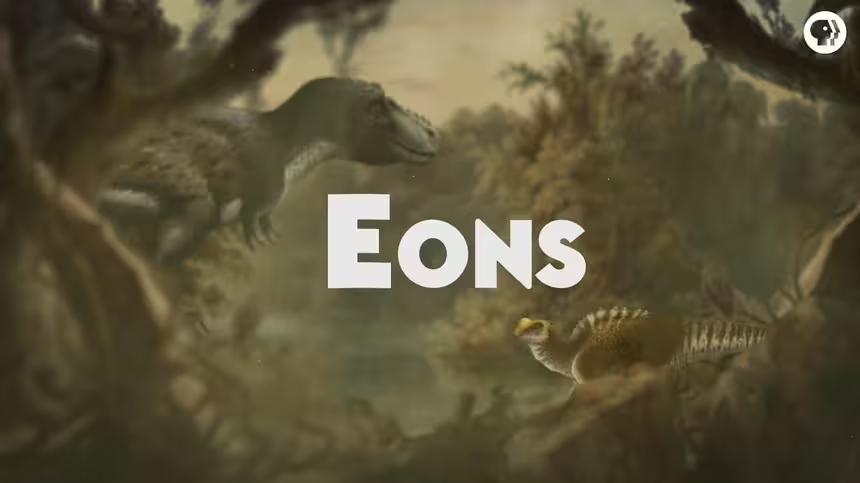
The Ancient Human Species With A Missing Body
Season 4 Episode 28 | 7m 56sVideo has Closed Captions
Would it really be impossible for us to reconstruct their morphology?
Only a handful of Denisovan fossils have been identified. In the absence of actual body fossils, it’s impossible for us to reconstruct their morphology, right?
Problems playing video? | Closed Captioning Feedback
Problems playing video? | Closed Captioning Feedback

The Ancient Human Species With A Missing Body
Season 4 Episode 28 | 7m 56sVideo has Closed Captions
Only a handful of Denisovan fossils have been identified. In the absence of actual body fossils, it’s impossible for us to reconstruct their morphology, right?
Problems playing video? | Closed Captioning Feedback
How to Watch Eons
Eons is available to stream on pbs.org and the free PBS App, available on iPhone, Apple TV, Android TV, Android smartphones, Amazon Fire TV, Amazon Fire Tablet, Roku, Samsung Smart TV, and Vizio.

Welcome to Eons!
Join hosts Michelle Barboza-Ramirez, Kallie Moore, and Blake de Pastino as they take you on a journey through the history of life on Earth. From the dawn of life in the Archaean Eon through the Mesozoic Era — the so-called “Age of Dinosaurs” -- right up to the end of the most recent Ice Age.Providing Support for PBS.org
Learn Moreabout PBS online sponsorshipIn 2010, we welcomed a newly discovered relative into the human family.
Excavations had been taking place in Denisova Cave in southern Siberia and one of the latest finds was a fragment of a pinky bone - tiny, but unusually well-preserved - dating to between around 50,000 to 75,000 years ago.
The researchers decided to try to sample some DNA from the pinky, to work out whether it came from a Neanderthal or from an ancient Homo sapiens.
But to their surprise, the results came back as...neither!
It turned out to be from a previously unknown type of ancient human.
They nicknamed them the Denisovans.
And the researchers were eventually able to sequence a full, high-quality genome from the pinky bone.
So we have a pretty good idea of what Denisovan DNA looked like…But, we still don’t really know what they actually looked like!
See, in the years since the discovery of the pinky bone, only a handful of other Denisovan fossils have been identified - including a few teeth, a bit of a skull, a shard of a long bone, and, most recently, a jaw fragment.
And in the absence of actual body fossils, it’s impossible for us to reconstruct their morphology, right?
Well, maybe we can!
Not just by studying the Denisovan genome, but by studying their epigenome - a kind of extra layer of chemical compounds that tells the genome what to do and when to do it.
And by puzzling out the Denisovan epigenome, researchers may finally be able to put a face to the name.
In paleontology, we’re pretty used to finding species that have left behind fossils, but no DNA.
Many extinct species are in this position, either because they died out too long ago for any DNA to survive or because of poor preservation.
But Denisovans are uniquely odd for being the exact opposite - we have essentially their entire genome, but hardly any fossils.
Now, their genome has helped us figure out a lot about them, like their ancestry and relationships to other branches of the human family tree.
For example, we know that they’re the closest relatives of the Neanderthals, who they diverged from around 400,000 years ago.
And we know that they interbred with both Neanderthals and Homo sapiens multiple times - with some populations of living people still carrying their DNA today.
…So we definitely knew what they looked like, at some point!
We even know that this particular Denisovan - a teenage girl based on the pinky size and shape - carried genes that in present-day humans are associated with dark skin, brown hair, and brown eyes.
But an ancient genome by itself, can’t bring their morphology to life the way a skeleton can – you can’t exactly look a genome in the face.
So, to paint a physical picture of them, scientists have had to get creative and try to squeeze out information about their anatomy in new ways.
Enter the field of Paleoepigenomics - which is just as sci-fi as it sounds.
It’s a new subfield of genomics that doesn’t just study the sequences of As, Ts, Cs, and Gs that make up a genome – it investigates one of the ways those sequences were controlled.
For example, there’s a set of chemical compounds called methyl groups, which can attach to DNA sequences and reduce their level of expression.
Think of them as volume knobs that can turn down the activity of genes.
These and other chemical tags make up the epigenome, and our understanding of the epigenome’s evolutionary importance has exploded in recent years.
After all, at the DNA sequence level, the genomes of Neanderthals, Denisovans, and Homo sapiens are over 99% identical – so what creates the differences in anatomy we see between these groups?
Like, we know that Neanderthals were generally much stockier than us, with wider chests, bigger skulls, and more pronounced brow ridges, for example.
Well, scientists have suspected that a key factor is how the genetic code is regulated by things like the epigenome.
So in 2014, a team of researchers developed a method that allowed them to map out which DNA sequences in an ancient genome would have had those methyl groups attached.
Their thinking was that if they could identify which sequences had methyl groups, they could assume that the activity of those sequences would have been turned down or switched off.
And by comparing the methylation map of the Denisovan genome to Neanderthals, humans, and chimps, they could see which regions differed in the Denisovans.
But how do you go from a methylation map to actual anatomy?
Well, that’s where we - Homo sapiens - come in.
See, there are a lot of known genetic conditions in living people where the same sequences that were turned down in Denisovans are switched off in us due to mutations.
And these often result in physical traits developing differently.
So the researchers realized that if they could match a turned down region of the Denisovan genome to a genetic condition in people today where the same sequence is turned off, they could infer what the anatomical consequences would have been for the Denisovans!
In theory, this approach could estimate information about certain traits, like, that one group would’ve had longer fingers than another, for example.
Although it wouldn’t be able to tell you exactly how much longer.
But before the researchers turned this method on the Denisovans, they first had to test if it could accurately predict physical traits.
So they tested it on two groups whose morphology is already well known: Neanderthals and chimps.
For Neanderthals, they were able to make predictions about 33 physical traits that would have differed between us and them.
And of those 33, they got 29 of them right - that’s what, like a B+?
For example, they correctly predicted that Neanderthals had broader faces and flatter heads than we do.
For chimps, it was a similar story.
The model got 20 of its 22 predictions right - a score of just over 90%.
A-!
Then they tried it for the Denisovans.
They were able to make predictions about how 32 Denisovan traits would have differed from us or Neanderthals.
And, bit by bit, a rough picture started to come into view.
21 of those traits matched those of Neanderthals, indicating they would have had a lot in common physically, including an elongated face, robust jaws, a wide pelvis, a large ribcage, and wide fingertips.
And this wasn’t surprising.
Neanderthals and Denisovans were more closely related to each other than either was to us.
But the remaining 11 traits included some that were distinct in Denisovans, such as a longer dental arch and wider skull, as well as a couple of traits that were predicted to resemble us, like prematurely losing permanent teeth.
Now, this method is very cool, but it’s also not 100% accurate or precise, and it will have gotten some things wrong.
But we don’t know which things and we can only test each prediction by finding more fossils.
Like, for example, that Denisovan jawbone fragment I mentioned earlier.
It was published in 2019 while this study was going through peer-review.
The researchers had already made predictions about Denisovan jawbone traits and 3 out of 4 of them turned out to match the fossil!
So it looks like paleoepigenomics is our best shot at painting a picture of the Denisovans…for now.
It seems pretty likely that more Denisovan fossils will be found… Whether they’re buried in cave sediment, locked away in permafrost, or just lying in museum drawers mislabelled as another hominin, they’re out there.
But until then, all we have to go on is an ancient genome and the remains of its chemical control system to give us a glimpse of the face of a Denisovan for the first time in tens of thousands of years.


- Science and Nature

A documentary series capturing the resilient work of female land stewards across the United States.












Support for PBS provided by:

